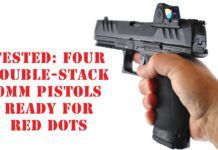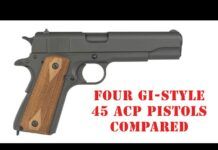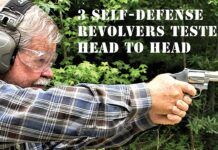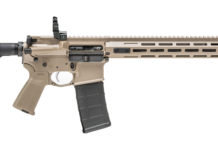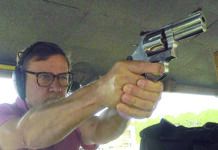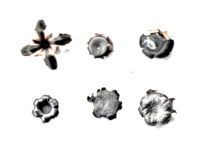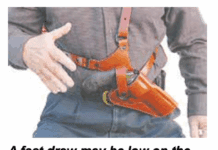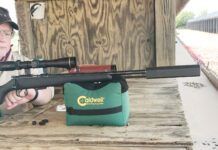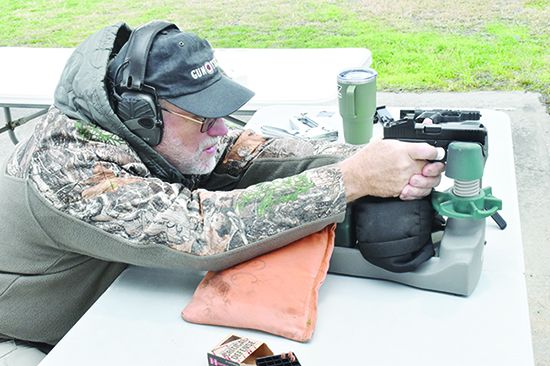Some members of the Houston test group are involved in teaching the Texas License To Carry class. The instruction includes a great deal of information about requirements for carry in Texas and the law regarding usage of those firearms. We also get asked about the best guns for carry. We tell them 1) the gun has to go bang, 2) it has to hit what they point it at, and 3) it needs to be sufficiently powerful. We normally recommend a minimum of 380 ACP. We also strongly suggest carrying a defensive firearm larger than a mouse gun, which tends to be easy to carry but is often difficult to shoot and has limited ammo capacity. Because we’ve never heard anyone who survived a gunfight say that they wish they had had a smaller gun or fewer cartridges, we normally suggest that they select the biggest gun they can, and will, carry.
Once properly enlightened, the LTC students most commonly choose a midsized pistol. The Glock Model 19 may well epitomize that group, but we think there are some other choices that are equally as good, or better. We collected three 9mm Luger samples that all sport less-than-full-length barrels and smaller frames but still maintain sufficient onboard ammo and good sights.
The first offering is one of the latest offerings from Canik. The Canik Mete SF HG5367, $455, ships ready for a red dot (as do the others) and comes compete with a real holster, tools, an extra backstrap, and even a magwell. It also sports one of the shortest, most usable triggers we’ve found on a polymer pistol.
The second is the Glock Model 48 MOS PA4850201FRMOS, $520. Roughly the same length and height as the famous G19, the G48 is slimmer, lighter, and easier to conceal while still allowing 10-round magazines. Of course, 15-round magazines are available aftermarket.
The third is Springfield Armory’s Ronin PX9117LAOS, $700. This is a Commander-length 1911-style pistol with a 4.25-inch barrel, blued slide, aluminum frame, and some very thin grips. Here’s what our shooters thought of these pistols when they fired the handguns side by side.
Glock Model 48 MOS PA4850201FRMOS 9mm Luger
$520
Gun Tests grade: A- [BEST BUY]
The Glock 48 is a medium-sized pistol that shoots well and is very easy to conceal. If those are your primary concerns, take a long look at the G48.

| Action Type | Semi-auto |
|---|---|
| Overall Length | 7.0 in. |
| Overall Height | 4.8 in. |
| Maximum Width | 1.06 in. |
| Weight Unloaded | 18.4 oz. |
| Weight Loaded | 24.8 oz. |
| Slide Material | Stainless steel |
| Slide Retraction Effort | 15.3 lbs. |
| Receiver Material | Polymer |
| Receiver Finish | Matte-black polymer |
| Slide Finish | nDLC |
| Front Strap Height | 2.25 in. |
| Back Strap Height | 3.0 in. |
| Barrel Length | 4.17 in. |
| Grip Thickness (Maximum) | 1.02 in. |
| Grip Circumference | 5.25 in. |
| Magazines | (3) 10 round |
| Rear Sight | Drift-adjustable white outline |
| Front Sight | Fixed white dot |
| Sight Radius | 6.25 in. |
| Trigger Pull Weight | 5.2 lbs. |
| Trigger Span | 2.25 in. |
| Safeties | Trigger, striker |
| Warranty | 1-year limited to original owner |
| Telephone | (770) 432-1202 |
| Website | Glock.com |
| Made In | Austria |
Glock Perfection is now in its fifth generation (some could argue sixth), and the guns have come a long way. The latest versions still possess the reliability for which Glocks are known as well as being slimmer, trimmer, and not as blocky. For example, we measured the depth of the grip on a vintage Gen 3 Glock Model 19 at the base of the trigger guard to be 2.05 inches. The same measurement on a Glock Model 47 (Gen 5) was 2.01 inches. That’s just 0.04 inch difference, but it is very noticeable for small- to medium-sized hands. For those with bigger hands, the newer Glocks generally come with multiple backstraps that can be added to fit the biggest bear paw. Slide width has remained the same on the standard models at just over an inch, but the latest iterations now have gasping grooves just back of the muzzle.
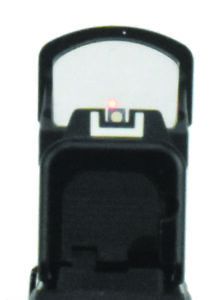
The frames have changed as well. Gone are the finger grooves that never quite seemed to fit any hand. The pebble-grain texture has been replaced by polymids that provide a more secure grip without being overly abrasive. Also, Glock changed out the magazine release to a larger model that can be moved to either side and that is much easier to engage. The magwells are nicely beveled, and a sample (Gen 5) Glock 47’s magwell shows to have been flared to allow easier mag changes.
The Model 48 takes the well-known Model 19 to a new level of concealability. The height and length of the G48 are almost identical to those of the Model 19. The changes were in the thickness of the slide and the grip. Our G19 measures just over an inch on the slide, while the G48 comes in at 0.87 inch, about a 14% reduction. The grip frame on our Gen G19 measures 1.17 inch versus a svelte 1.02 inch for the G48. The new G47 measures a max width of 1.31 inch with the flared magwell. Little of this matters to those with monster hands or who are not trying to conceal the pistol, but the changes are greatly appreciated for those with medium-sized hands or smaller. One of the downsides of the grip reduction is the magazine. Factory mags can only hold 10 rounds in an almost single-stack configuration. But because these are Glocks, there is probably an aftermarket part for everything. We found 15-round magazines available through Shield Arms (ShieldArms.com) that one of our testers has been using in a G48 for several years with virtually perfect results. Please note that if you change up to the 15-round mags, you should also change out the magazine catch to the steel version, also available through Shield Arms.
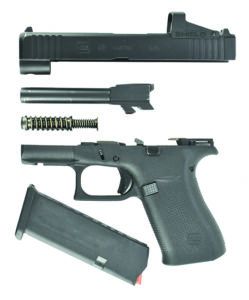
Glock adds a few more features to the G48. The new model uses a match-grade Glock Marksman Barrel, which sports more conventional rifling than the older models. It uses a shorter-reset trigger that we found to be one of the best we’ve ever tested on a Glock. At 5.2 pounds of required compression weight, the G48 trigger was the heaviest in this test, but it was crisp and consistent, making it easy to shoot. The latest-generation Glocks use a front sight that is held on with a screw instead of a press-fit pin. Once again, aftermarket parts are plentiful. We confess to liking the fiber-optic sights from Dawson Precision (DawsonPrecision.com). The rear sight on the G48 MOS is even better. This one is cut for red-dot sights though, obviously, not all will fit. The G48 is set up for a micro-red-dot sight, and the SMSc from Shield ($400, and a different company than the magazines noted above) worked well for us. Accepting the red dot directly on the slide, the G48 still has room for the factory rear sight, which can co-witness through the red-dot sight. The entire package weighed just under 20 ounces on our scales. Carried in a pancake holster from Simply Rugged Holsters (SimplyRugged.com) or a Kydex rig from Comp-Tac (Comp-Tac.com), the pistol snuggles nicely into the shooter’s side and almost disappears under a cover garment.
Our Team Said: The G48 was not quite as accurate or as fast as the all-metal Ronin. The Glock was also a half-pound lighter and could carry as much or more ammo with aftermarket mags. It was easy to carry the G48 all day long and forget we were carrying it.
| 9MM LUGER RANGE DATA | |||
|---|---|---|---|
| Hornady Critical Defense 115-grain FTX 90260 | Springfield Ronin | Glock Model 48 | Canik Mete SF |
| Average Velocity | 1164 fps | 1126 fps | 1130 fps |
| Muzzle Energy | 346 ft.-lbs. | 324 ft.-lbs. | 326 ft.-lbs. |
| Best Group | 0.81 in. | 1.54 in. | 0.93 in. |
| Average Group | 1.28 in. | 1.72 in. | 1.25 in. |
| Aguila Ammunition 124-grain FMJ 1E092110 | Springfield Ronin | Glock Model 48 | Canik Mete SF |
| Average Velocity | 1121 fps | 1083 fps | 1109 fps |
| Muzzle Energy | 346 ft.-lbs. | 323 ft.-lbs. | 339 ft.-lbs. |
| Best Group | 1.00 in. | 1.43 in. | 1.42 in. |
| Average Group | 1.33 in. | 1.76 in. | 2.37 in. |
| Fiocchi Range Dynamics 147-grain FMJ 9APD | Springfield Ronin | Glock Model 48 | Canik Mete SF |
| Average Velocity | 977 fps | 939 fps | 943 fps |
| Muzzle Energy | 312 ft.-lbs. | 288 ft.-lbs. | 290 ft.-lbs. |
| Best Group | 1.23 in. | 1.47 in. | 1.13 in. |
| Average Group | 1.42 in. | 1.55 in. | 1.54 in. |
We compared our test guns at American Shooting Centers (AMShootCenters.com) in west Houston. We tested using three different types of ammunition. We started off with Hornady 115-grain Critical Defense loads, Aguila 124-grain full metal jackets, as well as Fiocchi 147-grain Range Dynamics FMJs. For accuracy, we fired five-shot groups at 15 yards from a well-sandbagged Caldwell Pistolero Shooting Rest (MidwayUSA.com 517357, $28) assisted by a Mini DRC Fortune Cookie from Wiebad.com (MINIFC, $75). We also wanted to test practical accuracy, so we did two additional tests. The first used 3-by-5 inch stickies attached to paper targets 5 yards downrange. We recorded first-shot times using 124-grain ammo. Then we shot three rounds, also at 5 yards, and using the same 3-by-5 inch label. The start position on all drills was from low ready. Velocities were obtained via the new Garmin Xero C1 Pro (Amazon, $600).
| DRILL NO. 1 DATA | |
|---|---|
| Pistol | Single Shot Average Time |
| Canik Mete SF | 0.78 |
| Glock Model 48 | 0.81 |
| Springfield Armory | 0.68 |
Process: Fire one shot from low ready at 3-by-5-inch label placed at 5 yards. Times in seconds are averages for eight repetitions.
| DRILL NO. 2 DATA | |||
|---|---|---|---|
| Pistol | 1st Shot | Split Average | Total Time |
| Canik Mete SF | 0.94 | 0.2 | 1.34 |
| Glock Model 48 | 0.99 | 0.26 | 1.51 |
| Springfield Armory | 0.72 | 0.2 | 1.12 |
Process: Fire three shots from low ready at 3-by-5-inch label placed at 5 yards. Times in seconds are averages for three repetitions.
Written and photographed by Joe Woolley, using evaluations from Gun Tests Team members. GT



